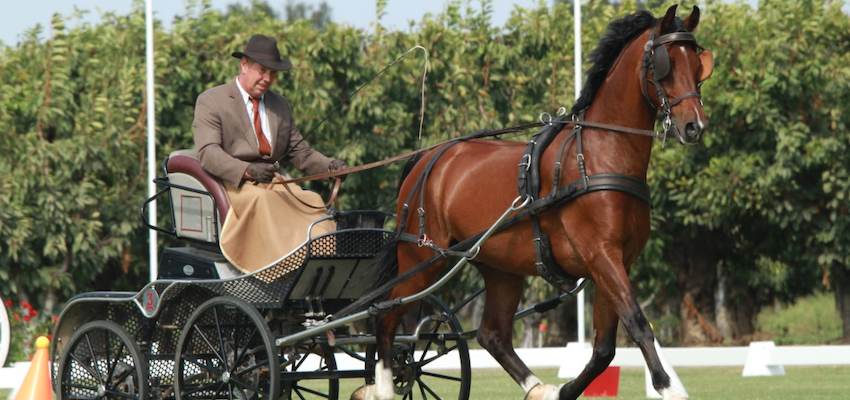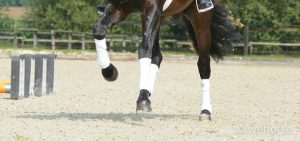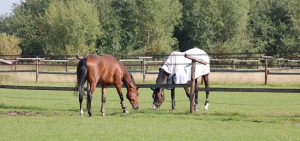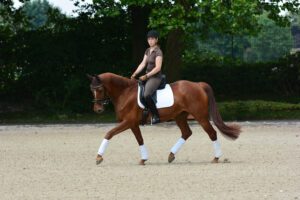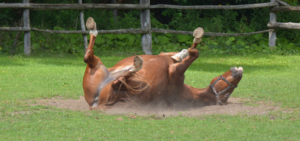The driving sport can be defined as driving a carriage with one, two, or four horses. In the past years, this discipline got a popularity boost and many new members. Whether you want to get involved for fun or to enter competitions, here is what you need to know.
Summary
- What Is Driving?
- The History of Driving
- What Are the Different Horse Driving Disciplines?
- What Makes a Good Driving Horse?
- The Carriage Types and Harness
- The Horse Pairs
- How to Get Started?
What Is Driving?
In short, the driving sport is about handling a carriage that can occur in many different styles and varieties. There are also different disciplines in the driving sport. They differ greatly in terms of requirements for horses and handlers. The most common disciplines are dressage-driving, cross country- driving, and obstacle driving. And what to keep in mind even though it seems obvious: The driving horse doesn’t carry but pulls- this has an effect on the gaits and the topline of the horse. Also, driving has just as much rich history as horse riding has. However, driving a horse instead of riding seems to keep the nostalgia of the past alive and offers a vintage vibe.
The History of Driving
The driving of horses has an even longer history than riding. Already thousands of years ago, mankind has put a cart before horses to move faster and more comfortably from one place to another or to move heavy loads. Even in ancient Greece, chariot races were a fixed part of the Olympic Games.
The driving sport has evolved from daily use: The driving of horses has proven especially useful in forestry and agriculture. This changed with the industrialization revolution and thus with the motorizing of vehicles that made horses obsolete. The purpose of driving horses has shifted since then from daily labor to a popular sport. Thanks to Benno von Achenbach- who revolutionized the driving sport in the early 20th century- driving became more horse-friendly and sustainable due to a new training system and an improved way of holding the leashes.
The first competition in driving took place in 1972 in Münster however it hasn’t had a comeback in the Olympic Games (yet). There are competitions for ponies and horses and for single, pair and four-in- hand carriages which are considered the “master class”.
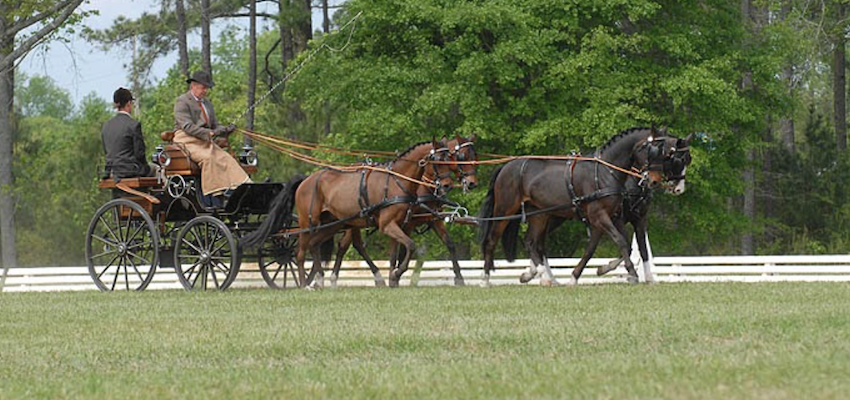
What Are the Different Horse Driving Disciplines?
The Achenbach-system is still the foundation for German and European driving instruction. It has a training scale that is somewhat similar to the training scale for riding horses. The goal is to have a horse that has been trained in these steps: Suppleness, collection, gymnastics and obedience.
In the driving sport, there are dressage competitions, obstacle driving, and cross country- also known as a marathon-competitions. The competitions can be judged either separately or together which results in a combined evaluation. The winner is the team who has the best results in all three disciplines. In the classic competition, there are also categories that separate the carriages into single, pair, and four-in-hand carriages. What also differs from riding competitions, is that there is the same difficulty and requirement level for horses and ponies when being presented in a driving competition.
In dressage, the focus lies on the gymnastics of the horse and the level of training that has been reached so far. It is very similar to dressage riding because the horse and driver have to perform a series of movements that include different figures and transitions.
In obstacle driving, on the other hand, the horse has to show swiftness, agility, obedience, and suppleness in order to accomplish the obstacle course. The course has to be finished in a set time and the obstacles are not to be touched. If the horse refuses to go past an obstacle or if the time is exceeded, points will be removed from the maximum number.
But the centerpiece of every driving competition is the cross country competition or marathon that enthralls with its spectacular obstacles that are either natural or artificial and include tight curves, bridges, and stream courses.
Then there is traditional driving which is very popular among the audience. This event is supposed to reminisce about the blooming period of driving that was about 1900. In this category, the handler and horse are presented before the jury, followed by an obstacle course with different tasks. Afterward, they often drive into the forest or field.
What Makes a Good Driving Horse?
In general, it can be said that any horse can be trained for riding or driving. However, a special horse type for driving has been bred for many years. The most popular breeds for driving are: Shetland ponies, Trotter, Freiberger, Friesians and Clydesdale.
The breeding-goals for a driving horse are: a stout and powerful exterieur, a rectangular frame, elastic gaits and a slant shoulder to carry the harness well and the horse while keeping an expressive and elaborate trot.
The interior of the horse is even more important when it comes to driving: The horse is supposed to be neither of a nervous or jumpy constitution and should have a balanced and calm nature. He should also be attentive to its environment and have a natural forward drive.
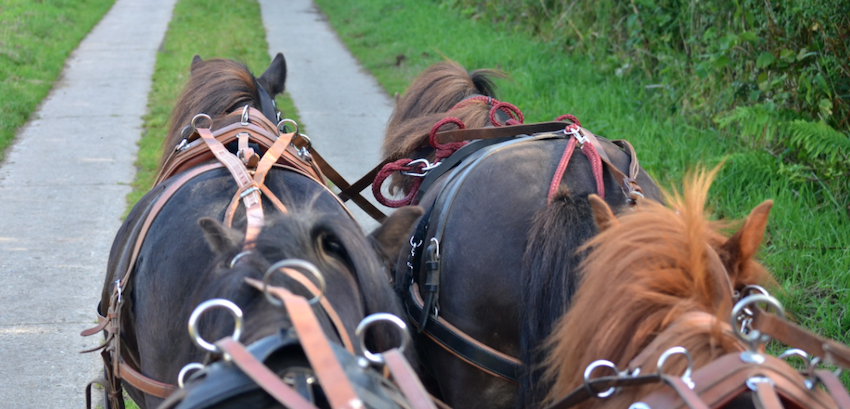
The Carriage Type and Harness
Carriages and chariots are available in many different styles and variations: The number of axes, the position of the charioteer, the style of the hood, and the array of passengers can differ greatly.
Carriages are either uniaxial or biaxial. When it comes to the harness of the horse, it can be differentiated between a city- or a countryside harness. The harness for the city is more elegant and the carriages are pompous and painted. The harness for the countryside is more practical and the carriages are in an untouched wooden style. The position of the charioteer depends if the passengers want to drive the carriage themselves or if it is driven by the coachman. The coachman’s seat can be behind, in front, or above the passengers.
The Horse Pairs
The horse pair for a carriage often stays together permanently as a pair because it is very difficult to find a good match at all. The horse’s pace have to fit together, their height, their character, as well as the exterieur. A horse pair also gets to know each other very well over time and tend to like to work together very much, as partners.
It is also common that the more experienced or secure horse goes on the left side due to the heavier traffic on the left side of the road. The inexperienced or faster horse goes on the right side, so he is sealed off the “danger zone”. It is also possible to compensate for a difference in height because the horse on the right side can look smaller due to the camber of the road.
How to Get Started?
The requirements for horse-friendly driving are first of all a horse that is agile, powerful, and supple and a driver who can communicate precise and subtle with the horse. This is why it is important to train a driving horse to go in front of a carriage with impulsion, straightness, and relaxation. The main goal is to guide the horse with minimal aids. This of course is only possible if the horse can think for himself.
The training scale that is known from the riding sport, can also be applied here: The points rhythm and regularity, relaxation, contact, impulsion, straightness and collection should guide the driver and his horse through the training process.
It is important to keep in mind that the application of the harness on the horse for the first time, must be prepared very carefully. So before the handler can even think about driving, he has to get his horse accustomed to the equipment. The horse has to feel comfortable and safe with the driving gear and only when this requirement is met, the handler can continue with the next step.
Next, the horse has to learn the basic aids. For this cause it is very much recommended to use the double lunge to teach the horse the relevant aids that are: transitions from one gait to another and also transitions within a gait and of course turning the horse!
If the horse understands these aids, the handler can continue to desensitize his horse to noise. It is very likely that a driving horse has to deal with noisy and spooky situations over the course of his “driving career”. The handler also needs to get his horse used to the weight of the carriage. This can be achieved by working with a drag the horse has to pull behind him. If the future driving horse has managed this step too, the handler can finally start with driving his horse.
It is recommended to start in a single carriage with one or two axes because this type is very stable due to the small tires and the track width. In the beginning, a second person should be present who leads the horse forward and calms him down. It is important that the horse goes forward constantly. It is also possible to drive the inexperienced horse in a two-in- a- hand carriage where a second and more secure horse offers safety and guidance.
As you can see (or rather read); Driving is a very versatile and also complex sport for handlers and horses. If this stylish sport with its vintage touch, has caught your interest, then go and find out more about driving by checking out the international driving trainer Frank Lütz!

